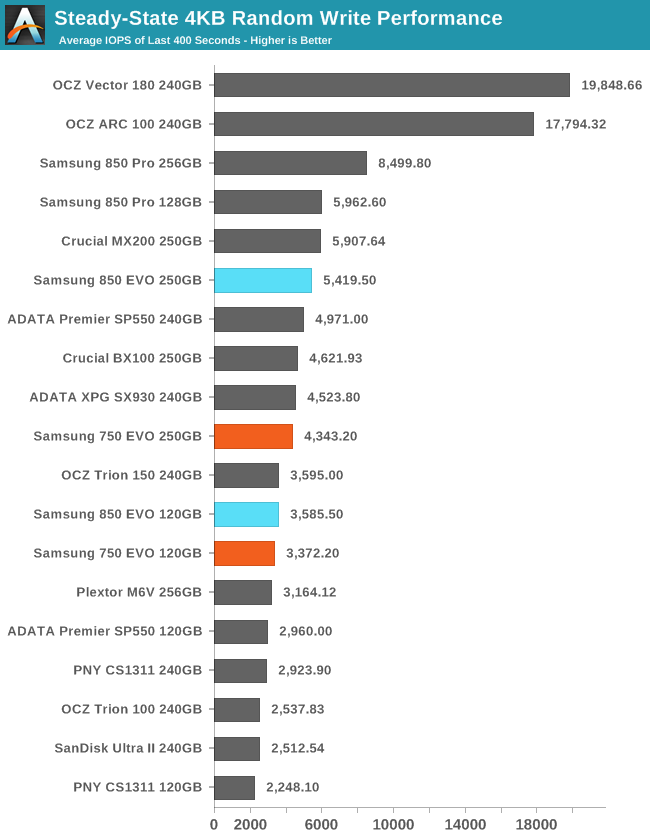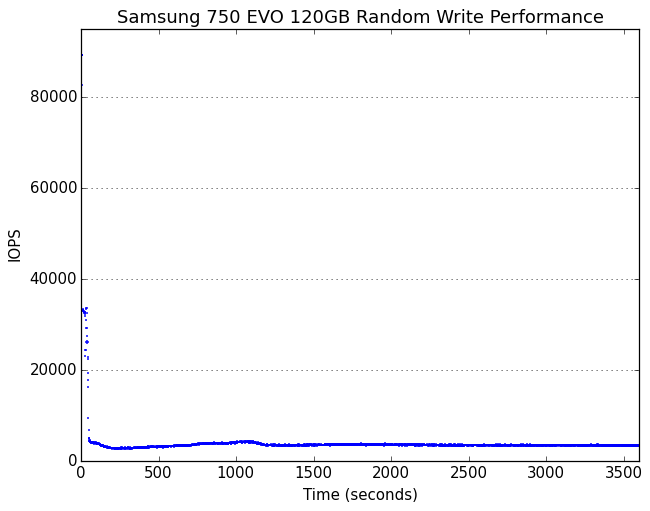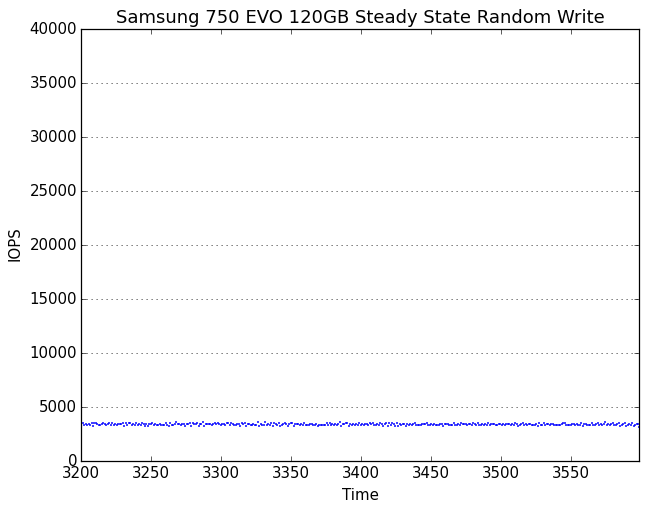The Samsung 750 EVO (120GB & 250GB) SSD Review: A Return To Planar NAND
by Billy Tallis on April 22, 2016 8:00 AM ESTPerformance Consistency
Our performance consistency test explores the extent to which a drive can reliably sustain performance during a long-duration random write test. Specifications for consumer drives typically list peak performance numbers only attainable in ideal conditions. The performance in a worst-case scenario can be drastically different as over the course of a long test drives can run out of spare area, have to start performing garbage collection, and sometimes even reach power or thermal limits.
In addition to an overall decline in performance, a long test can show patterns in how performance varies on shorter timescales. Some drives will exhibit very little variance in performance from second to second, while others will show massive drops in performance during each garbage collection cycle but otherwise maintain good performance, and others show constantly wide variance. If a drive periodically slows to hard drive levels of performance, it may feel slow to use even if its overall average performance is very high.
To maximally stress the drive's controller and force it to perform garbage collection and wear leveling, this test conducts 4kB random writes with a queue depth of 32. The drive is filled before the start of the test, and the test duration is one hour. Any spare area will be exhausted early in the test and by the end of the hour even the largest drives with the most overprovisioning will have reached a steady state. We use the last 400 seconds of the test to score the drive both on steady-state average writes per second and on its performance divided by the standard deviation.

Starting with a look at steady-state performance, the 750 EVO is clearly inferior to the 850 EVO, particularly at 250GB. But it outperforms most of the planar TLC competition and the occasional low-end MLC drive.

The high consistency score is a hallmark of Samsung's top-notch controller architecture. The 750 EVO is in an entirely different league from the planar TLC drives.
 |
|||||||||
| Default | |||||||||
| 25% Over-Provisioning | |||||||||
The 750 EVO's initial burst of high performance is relatively short-lived, but it transitions into a very well-regulated steady state. The gradual performance recovery before a second smaller drop in performance is less pronounced than on the other Samsung drives, but is still present.
With extra overprovisioning, the 750 EVO's steady state shows much looser performance regulation but is still delivering a better worst-case than its competition's best-case.
 |
|||||||||
| Default | |||||||||
| 25% Over-Provisioning | |||||||||
A closer look at the 750 EVO's steady state is pretty boring, with no clear patterns of periodic background maintenance or sporadic outliers.










109 Comments
View All Comments
Coup27 - Friday, April 22, 2016 - link
SATA is not yesterdays tech.abrowne1993 - Friday, April 22, 2016 - link
More like yesteryearDeath666Angel - Friday, April 22, 2016 - link
So, everyone with perfectly capable CPUs that are barely slower than current tech should upgrade because SATA is old? I'm not disputing that SATA is the older tech, I'm just looking for a more nuanced and realistic view here. If your workload is sufficiently dependant on IO throughput, by all means get those NVMe drives. But implying that a SATA3 device like a 850pro is not going to do the job for a lot of people.... I have a Z87 4770k running at 4.5GHz. I'm not going to upgrade just for the convenience of M.2 PCIe NVMe support. And I won't do so until 6+ core CPUs with comparable IPC and OC abilities get decently priced.Meteor2 - Saturday, April 23, 2016 - link
No, not at all, and no-one said SATA is inadequate. But it is part of the past, just like 486s and dial-up modems.Bleakwise - Sunday, April 24, 2016 - link
No, SATA has a place. You realize a 2.5 SATA drive has about 10x-20x the volume of a NVME drive. No reason you could n't have a 3.5 inch SATA SSD either.Thus SATA will always be the go-to for high volume storage. Flash memory isn't going to be shrunk down anytime soon either, it degrades both performance and reliability, so until we get something better than flash SATA is going to be the only place you can get something like a 4TB or 8TB SSD.
Bleakwise - Sunday, April 24, 2016 - link
Shinking thing smaller and smaller is also more expensive, and like I said in terms of flash it also degrades performance. It's much cheaper to build a big-fast thing than a small-fast thing.There is also the issue of RAID and mechanical drives for mass storage. I can setup a 20TB fakeraid with an SSD write-back cache for under a thousand dollars. Hardware raid would be about 2000$. The NVME version would be about 8000$ to 10000$.
Billy Tallis - Sunday, April 24, 2016 - link
There are 2.5" NVMe drives using the U.2 connector to provide the same 4 lanes of PCIe that can be supplied by the M.2 connector.slowdemon21 - Friday, April 29, 2016 - link
Agree. SATA is the skylake bottleneckewitte - Tuesday, May 24, 2016 - link
I hacked my bios to run a 950 pro in a z87 it was ridiculous to spend so much upgrading from a 4790k.Coup27 - Friday, April 22, 2016 - link
Do you not think there is something wrong with the phrase "consumer grade NVMe 2TB+ SSD" ?You could also RAID some SATA 2TB SSD's to give you want you need. I doubt you "really" need all of that space on NVMe, so maybe a 256 or 512GB 950 Pro + some 850 EVO's in RAID would work well, and is available now.